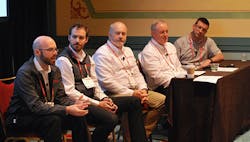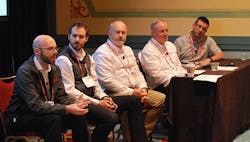Manufacturers get SaaS-y
Five expert panelists in Rockwell Automation’s Software and Control division emphasize that cloud computing and software as a service (SaaS) can streamline every type of industrial application.
Cloud computing and software as a service (SaaS) can land industrial users on the shore of a new world of performance benefits. They just need to steer toward solutions to bring that promised land into sharp focus.
This was the essential assessment of five experts in Rockwell Automation’s Software and Control division who discussed cloud-based industrial automation Software on the second day of ROKLive 2022.
“Digital transformation is a big trend, but COVID-19 had an even bigger impact on it,” said Leo Kilfoy, director of digital design, SaaS and FactoryTalk Hub at Rockwell Automation. “The pandemic accelerated digital transformation by users seeking to gain efficiencies, develop services and address other business changes. Now, they’re scaling digital transformation with cybersecurity, cloud-computing, artificial intelligence (AI), data analytics and automation, which is right where we can help.”
Adam Gregory, commercial software leader for next-generation design software at Rockwell Automation, added that digital transformation is paralleling a shift to a more modern way of thinking and bringing additional software-based practices to manufacturing. “Rockwell Automation’s programmers are using and getting increasingly excited about IT tools and how industrial processes can adapt to use them,” said Gregory. “These include FactoryTalk Vault and FactoryTalk Hub with cloud services like Microsoft Azure and Amazon Web Services on the backend, which let users employ design tools and object-oriented programming to build applications more easily.”
Saving grace of SaaS
Several panelists stressed that the primary advantages of SaaS are that its software and security functions are always up to date because they remain the responsibility of their providers, which frees users from former and often arduous patch management, software version control and security update tasks.
“It recently took us two hours to download some new video-processing software, and this was precisely the kind of job that SaaS would allow us to avoid. With SaaS, we’d have immediate access to the new version,” explained Oliver Haya, marketing manager for edge-to-cloud at Rockwell Automation.
Steve Briant, platform lead for next-generation visualization and FactoryTalk Optix at Rockwell Automation, added that SaaS lets users log in to a web browser for ubiquitous access from anywhere to its assigned software applications and services. “Many of us enjoyed these new features, such as using Microsoft Teams, during the pandemic without having to download the software,” said Briant. “This zero-overhead model is something we all appreciate.”
Beyond access to computing functions and files, SaaS also enables users to develop and deliver new content and value to colleagues and clients, said Chris Como, principal platform leader for FactoryTalk Design Hub at Rockwell Automation. “This week, our customers are seeing that we have new capabilities they can try out, especially in FactoryTalk Design Hub,” said Como. “This really changes the whole cadence of how we develop and release solutions because we can deliver them much faster.”
Scaling up, savings and sharing
The panelists also reported that, not only can SaaS in the cloud allow new capabilities, it can also multiply those solutions as needed, dramatically increase its computing power to meet the needs of data-intensive tasks and make formerly difficult jobs simpler to handle.
“The cloud makes it easier to increase and apply CPU power more quickly. We can also scale horizontally, and run five or more applications at the same time,” added Kilfoy. “I used Emulate3D software on the cloud yesterday to simulate a canning line on my laptop, and it ran as smooth as silk. It can run large applications for performance scaling and bring together teams for projects. If you need to do virtual commissioning, you can do what you need to do and drop out when you’re done.”
Briant added that Rockwell Automation’s upcoming FactoryTalk Optix software uses the same cloud-service model, so users only need to purchase as much capacity as they’re actually going to use. “No one wants pay for something they won’t use, so we’re also building subscription and consumption models, which can both be classified as operating expenses (OpEx), and produce added cost savings.”
In addition to immediate financial benefits, SaaS in the cloud can also generate savings indirectly by allowing users to share files and save valuable time, as well as see who made what changes to which file. “FactoryTalk Design Hub brings together multiple personas, who can ask each other about items like the AutoCAD program they’re using, wiring on a project, an HMI or PLC they’re developing or anything they’re doing to build a global solution,” added Como. “This is very similar to the in-person collaboration they’ve always done.”
However, one of the unshakable infrastructure requirements for SaaS in the cloud is maintaining a good Internet connection, said Haya. “This can be an issue because some plants have poor Internet links, but connectivity and performance are much more closely tied these days. SaaS needs good connections at the edge, so it can build out from there. SaaS and the cloud are just another tool in the box, but we’re not replacing the box,” he explained.
“We’ll always maintain an on-site version of software if users need it, and it can run in conjunction with the cloud,” said Gregory. “However, even though not everyone is ready for it yet, cloud and SaaS are the next wave.”
The editors of Control, Control Design and Smart Industry are reporting live from ROKLive 2022 in Orlando, Florida, to bring you the latest news and insights from the event. When the event comes to a close, the best, most important coverage will be compiled into a report by the editors.
Register now to pre-order the report and be among the first to receive it in your inbox.
About the Author

Leaders relevant to this article:


